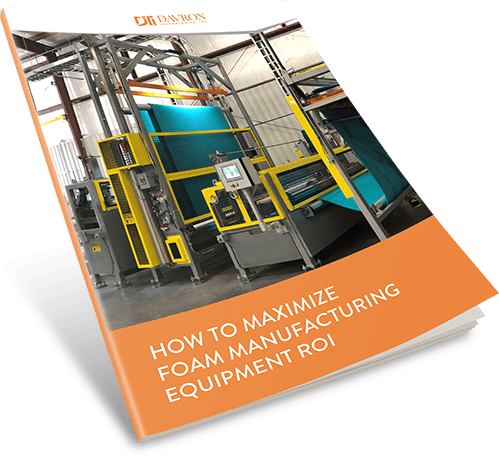For industrial foam manufacturers, buying the equipment that makes and prepares continuous web foam products for sale is arguably their most critical capital expenditure.
Boiled down, there are two pathways to procuring this crucial machinery. Continuous updates of individual manufacturing stages are more common. Less common is the integration of an entire manufacturing line at once.
Is one way better than the other?
Our stance is that almost any continuous web foam manufacturer’s production can be made more simple, efficient and profitable with integrated machinery made by a single provider.
Below are the cost-specific reasons why we believe what we do. (You can read about operational benefits of integrating whole systems here.)

Acknowledge the sticker shock fallacy
Buying an entire line at once, whether from a single source or piecemeal from separate providers, comes with some sticker shock. Even if it makes operational sense to add or update entire lines all at once, the size of this single outlay might be more than a manufacturer is willing to stomach.
But sticker price is only a surface-level cost. Many other factors combine to reveal the true cost of ownership. We encourage manufacturers to investigate them in depth. It’s harder, more tedious work to understand the impacts those factors will have, but it’s information well worth knowing.
Whole systems are less expensive and faster to engineer
Engineering through all the manufacturing steps is done at once by a single team. Not only does this result in paying for fewer total hours of engineering time, the engineering itself is stronger and more integrated. It can anticipate future equipment updates much more effectively than the tunnel-vision engineering of individual machines.
Integrated engineering also makes whole systems cheaper and more efficient to operate. This is because system engineers can consider and account for all of your process requirements at once. Not only does this create a more efficient line, it allows engineers and manufacturers to think holistically about ways to improve manufacturing efficiency. The engineering of separate machines inherently cannot account for the full picture the way whole-system engineering can.
In-depth buyer's guide
How to maximize foam manufacturing equipment ROI

Whole systems reduce delivery and installation costs
Even before a manufacturing line begins operation, manufacturers can realize significant savings when buying entire systems from one provider. The cost to ship the equipment is reduced, installation is coordinated from a single point of contact and only one deadline looms over a project rather than several.
In addition, integrated engineering accounts for the smooth transition of product from phase to phase. Disparate systems cannot account for those transitions as well, introducing the risk that costly field modifications are required.
Whole systems optimize labor
A key advantage of whole-system engineering is that entire lines can run on a single HMI framework. By not needing to integrate dissimilar machinery, manufacturers sink less time and money in training the labor force. Similarly, whole-system design accounts for labor requirements and user flows in ways that piecemeal procurement cannot.
Because engineers who design whole systems can think more broadly about user interface, footprint and user flows, they can collaborate with manufacturers to develop more highly automated manufacturing lines that reduce a facility’s overall labor requirement.
Maintenance is faster, easier and cheaper with whole systems
Downtime is the archenemy of profitable manufacturing. Whole systems reduce downtime because maintenance teams need only to consult one manual during troubleshooting. They also give manufacturers a single point of contact for support.
In addition, part replacement is streamlined because whole systems are value-engineered to use the same brands and part types across an entire line.
Whole systems offer more flexible financing
Imagine paying for the engine, the body, the wheels and other components that make up a car separately instead of just buying a car. How well the car works isn’t necessarily tied to how it’s paid for, but such a vehicle would be an administrative nightmare to own.
The same is true for foam manufacturing equipment. Manufacturers can secure more consistent payment terms when they pay for whole systems instead of purchasing lines piecemeal from separate vendors, each with its own financing policies. Similarly, the warranty plans for whole systems and the components they include leave fewer gaps in coverage compared to piecemeal equipment purchases.
Think bigger & earn more with single-source lines
Capital expenditures are serious enough as it is. We believe making several of those purchases over and over again just to maintain a single manufacturing line makes things more difficult than they need to be.
If you’re intrigued by whole-system thinking for continuous web foam manufacturing but are having trouble visualizing the impact it would make in your facility, we’ll help you think it through. Everything we build is custom-engineered, and that means our team gets to know your facility and its operations almost as well as you do.






